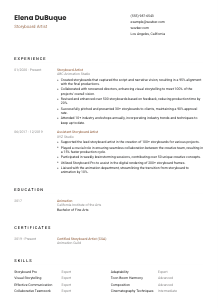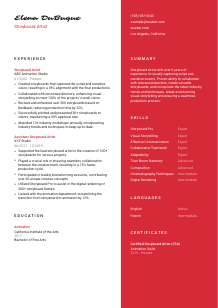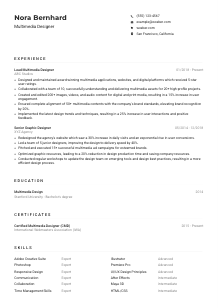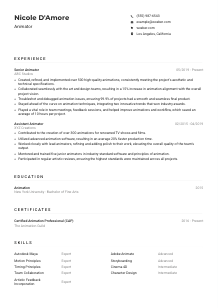Storyboard Artist Resume Example
Illustrating narratives, but your resume isn't gaining plot twists? Dive into this Storyboard Artist resume example, mapped out with Wozber free resume builder. See how you can frame your visual storytelling skills to align with job narrative, ensuring your career arc never hits a blank panel!

How to write a Storyboard Artist Resume?
Welcome to your tailored guide to drafting an unforgettable Storyboard Artist resume with Wozber, your ally in climbing the competitive ladder of the animation and film industry. This isn't just about listing your experiences; it's about telling your unique story in a way that resonates with your dream job's expectations while ensuring ATS compliance. Armed with insights specific to Storyboard Artists and Wozber's free resume builder, including its ATS-friendly resume templates and ATS resume scanner, you're about to transform your professional narrative into an engrossing visual script that captivates hiring managers.
Personal Details
In the world of animation and storytelling, every frame counts - and so does every section of your resume. Starting strong with your personal details sets the stage for your professional narrative. Let's ensure your contact information is as beautifully presented as the storyboards you craft, guiding you to tailor this essential section with precision.
1. Be the Headliner
Your name is the title of your professional story. Ensure it's prominently displayed using a clear, professional font. This primes the scene, making your name memorable.
2. Position Yourself
Directly underneath your name, align yourself with the role by specifying "Storyboard Artist". This straightforward tactic positions you perfectly for the role in the minds of the hiring team from the get-go.
3. Essential Contact Details
Provide your most accessible phone number and a professional email address. A format like firstname.lastname@email.com keeps it professional and simple. If you have a portfolio or LinkedIn profile that showcases your storyboard projects, include these as well. Ensuring these links are clickable in your digital resume simplifies the hiring manager's task to explore your work.
4. Localize Your Lore
"Must be located in Los Angeles, California" - the job description spells it out. Highlighting your Los Angeles, California residence not only ticks a major requirement box but also reassures the hiring team there's no need for relocation considerations.
5. Trim the Excess
Storyboard Artists tell stories through visuals, omitting unnecessary details to maintain focus. Apply the same principle to your personal details. Skip any information not directly relevant to your professional journey as a Storyboard Artist, such as marital status or hobbies, to keep the narrative tight and impactful.
Takeaway
Just like setting up the first scene of a storyboard, your personal details section sets the tone for your resume. Clean, professional, and targeted - it's your first step towards making a strong, relevant impression. Think of it as your opening shot, framing you perfectly for the role of a Storyboard Artist.





Experience
Your experience section is like a dynamic storyboard sequence, showcasing your journey through the industry. It's not about listing every scene you've been a part of; it's about highlighting those moments where your skills truly shined. Here's how to craft your professional experience to reflect the storyboard artist job requirements, proving you're ready to bring the narrative to life.
- Created storyboards that captured the script and narrative vision, resulting in a 95% alignment with the final productions.
- Collaborated with renowned directors, enhancing visual storytelling to meet 100% of the projects' overall vision.
- Revised and enhanced over 500 storyboards based on feedback, reducing production time by 20%.
- Successfully pitched and presented 30+ storyboards to clients, maintaining a 90% approval rate.
- Attended 10+ industry workshops annually, incorporating industry trends and techniques to keep up‑to‑date.
- Supported the lead storyboard artist in the creation of 100+ storyboards for various projects.
- Played a crucial role in ensuring seamless collaboration between the creative team, resulting in a 15% faster production cycle.
- Participated in weekly brainstorming sessions, contributing over 50 unique creative concepts.
- Utilized Storyboard Pro to assist in the digital rendering of 200+ storyboard frames.
- Liaised with the animation department, streamlining the transition from storyboard to animation by 10%.
1. Analyze the Script
Begin by dissecting the job description. Each requirement, like "Minimum of 3 years experience in storyboarding for film, TV, or animation," directs you to plot points your resume needs to hit. This analysis is your storyboard for tailoring your experience.
2. Set the Sequence
List your professional experiences in reverse chronological order. For each role, clearly state your job title, the studio or company, and the dates of employment. This structure provides a clear timeline, guiding the reader through your career storyline.
3. Detail Dynamic Scenes
Focus on accomplishments that align with the provided job description's demands. Statements like "Created storyboards that captured the script and narrative vision, resulting in a 95% alignment with the final productions" directly reflect your impact and expertise in crucial areas such as visual storytelling and team collaboration.
4. Quantify the Impact
Numbers draw attention and add credibility. Whether it's the percentage of projects you enhanced, storyboards created, or hours saved in production, quantifying your achievements makes your contribution concrete and memorable.
5. Relevance is Key
As tempting as it might be to list all your experiences, maintain focus on those that are directly relevant to storyboarding. Each bullet point should be a frame in your career storyboard, leading naturally to why you're the perfect fit for this role.
Takeaway
Crafting an experience section that reads like a compelling storyboard narrative is your goal. By being selective and emphasizing relevant accomplishments, you create a vivid portrayal of your professional journey, demonstrating your suitability for the storyboard artist position with clarity and impact.
Education
Like the foundational sketches of a storyboard, your educational background sets the stage for your expertise. While it may seem straightforward, presenting this section with a touch of creativity can further highlight your suitability for the Storyboard Artist role. Let's refine your education section to make every detail support your narrative.
1. Identify Core Requirements
The job specifies a "Bachelor's degree in Animation, Fine Arts, or a related field." Make sure your degree, especially if it directly matches, is front and center. This instantly shows you meet one of the fundamental criteria.
2. Structure with Purpose
Present your educational background in a clear format: the degree title, followed by the field of study, the institution, and your graduation year. This clean, direct presentation makes it easy for hiring managers to verify your qualifications.
3. Match the Script
When your degree directly aligns with the role, such as a "Bachelor of Fine Arts in Animation," it not only meets the specified requirement but also reinforces your dedication and specialized knowledge in the field.
4. Feature Relevant Coursework
Especially for those early in their career or with specific niche skills, listing relevant coursework can bolster your qualifications. This could include specialized training in storyboarding software or narrative construction courses.
5. Highlight Additional Achievements
If you've achieved notable academic honors, led relevant projects, or took part in animation clubs or societies, these details can serve as a testament to your passion and commitment to your craft. Just be sure to consider their relevance based on the role's seniority.
Takeaway
Your education section should be more than just a list of schools; it's the sketch that outlines your foundational knowledge and dedication. By aligning it with the role's requirements, you're showcasing not just your qualifications, but your readiness to thrive as a Storyboard Artist.
Certificates
In the fast-evolving world of animation and storytelling, continual learning is key. While not explicitly mentioned in our example job description, relevant certifications can distinguish you as a candidate committed to your craft. Let's illustrate how to feature your certifications to complement your resume narrative.
1. Reflect on Relevancy
While the job description may not list specific certifications, choosing to include those most relevant to storyboarding, such as "Certified Storyboard Artist (CSA)" from the Animation Guild, can add weight to your application. This demonstrates ongoing professional development and expertise.
2. Selectively Showcase
Focus on certifications that underscore your knowledge of storyboarding software, visual storytelling, or other skills highlighted in the job requirements. This curation ensures your resume remains targeted and impactful.
3. Date Matters
For certifications with a renewal cycle, including the dates showcases your current knowledge and commitment to staying updated in your field.
4. Pursue Growth
Continuously seeking new learning opportunities, especially those aligned with your career aspirations, shows prospective employers your dedication to professional excellence and growth.
Takeaway
Selectively featuring relevant certifications in your resume is like adding those perfect finishing touches to a storyboard – they enhance the overall narrative and reinforce your expertise. Stay dedicated to learning and development; it's an investment in your craft and career.
Skills
Your skills section is the frame-by-frame breakdown of your professional toolkit. As a Storyboard Artist, showcasing both your technical prowess and soft skills tailored to the job's requirements ensures a multidimensional portrayal of your capabilities. Let's storyboard a skills section that speaks volumes.
1. Highlight the Right Tools
Dive into the job description to identify both the explicit skills, like "Proficiency with storyboarding software such as Storyboard Pro or Toon Boom Harmony," and the implicit ones, such as teamwork. This dual focus outlines your technical capabilities and soft skills.
2. Prioritize Pertinence
Align your skills with those mentioned in the job description. Being proficient in "Storyboard Pro" and possessing a strong understanding of "Visual Storytelling" directly matches the job's needs, showcasing your expertise in both essential tools and conceptual prowess.
3. Organize for Impact
While it might be tempting to list every skill you possess, focusing on those directly relevant to the role ensures clarity and impact. Organize your skills in a way that draws the hiring manager's eye to your strongest and most relevant capabilities first.
Takeaway
Think of your skills section as a crucial frame in the storyboard of your career. It succinctly communicates your expertise, ensuring each skill you list directly supports the narrative that you're the ideal candidate for the Storyboard Artist position. Keep refining and expanding your professional toolkit; it's your passport to dynamic opportunities.
Languages
In the diverse and collaborative world of animation and film, the ability to communicate across cultures can be a distinctive advantage. While our job example specifically demands strong English skills, showing linguistic diversity can elevate your narrative in a global industry. Here's how to weave your multilingual prowess into your resume.
1. Script the Requirement
Given that "Strong English speaking and writing abilities required" is explicitly stated, your fluency in English must be highlighted upfront, showcasing your capability to meet this fundamental requirement.
2. Showcase Linguistic Diversity
After confirming your proficiency in English, listing additional languages can demonstrate your adaptability and readiness to engage in diverse workplaces or international projects. Your multilingual abilities suggest a broader communicative reach and cultural sensitivity.
3. Level with Honesty
Clearly indicate your level of proficiency for each language using terms like native, fluent, intermediate, or basic. This honesty about your linguistic capabilities sets realistic expectations and underscores your integrity.
4. Connect to the Role's Scope
For roles involving cross-cultural teams or projects, your language skills could be a unique selling point. Assess the role's requirements and scope to determine the value of highlighting additional languages beyond the primary one required.
5. Embrace the Global Stage
The animation and film industries are increasingly global. Being conversant, or even fluent, in additional languages opens doors to broader opportunities and enriches your collaborative potential, making you a more versatile and appealing candidate.
Takeaway
Language skills can significantly enhance your resume, showcasing not just your ability to communicate, but also your readiness to operate in a global industry. With storytelling being an inherently universal endeavor, your linguistic abilities highlight your potential to narrate across cultures and boundaries.
Summary
Crafting a gripping summary is like setting the stage for an epic tale. It draws the reader in, offering a teaser of your professional journey as a Storyboard Artist. A well-composed summary can distinguish you at first glance, encapsulating your expertise and passion. Let's storyboard a summary that leaves hiring managers eager to read on.
1. Scene Setting
Begin with a concise introduction that positions you within your field. Mentioning over 6 years of experience is not just a statement of time; it's an opening line that sets the context for your depth of expertise and dedication to your craft.
2. Feature the Highlights
Articulate a few of your paramount skills and accomplishments, drawing directly from your interpretive reading of the job description. Emphasizing your proficiency in "visual storytelling" and successful collaborations echoes the script's demands, offering a snapshot of your career highlights.
3. Craft Concisely
The essence of a compelling summary lies in brevity and impact. Aim for a succinct portrayal that teases the reader with your qualifications and leaves them wanting more. This isn't the place for exhaustive detail; it's the high-impact trailer for your career story.
4. Direct the Narrative
Your summary isn't just a rundown of your qualifications; it's the pitch that sets you apart. Including a nod to your adaptability and continuous learning, such as staying "up-to-date with industry trends," signals your proactive stance and dynamic approach to evolving within your profession.
Takeaway
A well-crafted summary gives a compelling preview of your professional narrative, enticing hiring managers to dive deeper into your resume. It should encapsulate the essence of your qualifications while aligning with the storyboard artist role you aspire to. With this opening scene so vividly set, you're ready to guide the audience through the captivating story of your career.
Launching Your Storyboard Artist Journey
You're now equipped with a guided path to crafting a resume that resonates with the unique requirements of the Storyboard Artist position. By embracing Wozber's free resume builder, including its ATS-friendly resume templates and ATS resume scanner for keyword optimization, you're not just preparing a document; you're framing your professional story in a way that speaks directly to your dream role. Let your resume be the storyboard that illustrates your journey, your skills, and your passion.
The stage is set, the scenes are drawn, and the narrative is yours to tell. Forge ahead and make your mark in the world of visual storytelling.

- Bachelor's degree in Animation, Fine Arts, or a related field.
- Minimum of 3 years experience in storyboarding for film, TV, or animation.
- Proficiency with storyboarding software such as Storyboard Pro or Toon Boom Harmony.
- Strong understanding of visual storytelling, composition, and cinematography techniques.
- Effective communication skills and the ability to collaborate within a team.
- Strong English speaking and writing abilities required.
- Must be located in Los Angeles, California.
- Create storyboards that depict the script and narrative vision for productions.
- Collaborate closely with directors, writers, and other creatives to ensure visual storytelling aligns with the overall vision of the project.
- Provide revisions and elaborations to storyboards based on feedback and direction from the creative team.
- Pitch and present storyboards to clients or stakeholders when necessary.
- Stay updated with industry trends, techniques, and technologies to continuously improve storyboarding skills.















